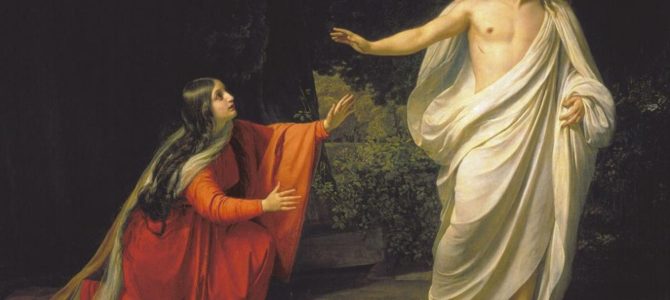
Saint Mary Magdalene,
you came with springing tears
to the spring of mercy, Christ;
from him your burning thirst was abundantly refreshed;
through him your sins were forgiven;
by him your bitter sorrow was consoled.
—St. Anselm, 1033–1109, prayer about St. Mary Magdalene
On July 22, Western and Eastern Orthodox churches, historians, and Christians around the world celebrate the feast day of saint Mary Magdalene, a faithful follower of Jesus Christ and the first witness to the Resurrection, according to the gospels.
Mary Magdalene, cured of seven demons (Luke 8:3), followed her healing savior on His earthly ministry from Galilee to Jerusalem to that final fateful Golgotha Hill where He was crucified. On the first Easter Sunday, carrying myrrh to anoint his body, Mary stood at the empty grave weeping. The risen Jesus appeared to her, called her by name, and commanded her to share the Good News of his resurrection. (John 20: 1-18).
“I have seen the Lord!” Mary told the disciples, earning her title from the early church fathers, “Apostle to the Apostles.”
Her tears at Christ’s empty tomb are a reminder that “sometimes in our lives, tears are the lenses we need to see Jesus,” preached Pope Francis, who elevated Mary Magdalene’s memorial day to a major feast day in 2016. “St. Mary Magdalene’s feast day is a call for all Christians to “reflect more deeply on the dignity of women, the new evangelization and the greatness of the mystery of divine mercy.” A new pilgrimage site dedicated to her has just been announced in France.
The U.S. Conference of Catholic Bishops has issued a liturgy for the July 22 Mass recognizing the saint, who is also recognized by the Eastern Orthodox Church and many Protestant denominations including the Lutheran church.
Last year’s tributes from around the world demonstrate the breadth of her significance: there were tweets from Westminster Abbey, the Greek Orthodox Archdiocese of America, French poet Antre Fascinante, Welsh author Mark Rees, art historian Elizabeth Lev of Rome, the Library of Birmingham Museums Trust, and even Simcoe Muskoka Catholic District School Board of Barrie, Ontario.
Where Did Mary Magdalene Come From?
In the town of Magdala, along the shore of the Sea of Galilee where Mary was born, commemorative services are held each year, recognizing her key role in sharing the good news of the gospel.
“At the beginning of the Gospel, we have a woman, the Virgin Mary….who consents and accepts to become the Mother of the Lord and welcomes him in her womb, beginning the history of redemption. At the end of the Gospel, we have a woman, Mary of Magdala, who enters first into a relationship with the Risen Lord…She is a figure of the Church, made of sinners, who are at the same time reconciled with the Father by the presence of the risen Christ,” said Archbishop Pierbattista Pizzaballa, patriarch of Jerusalem of the Latins, in his homily.
Hippolytus, a key Catholic theologian and bishop in the third-century, was the first to call Mary Magdalene “apostle to the apostles,” words echoed by St. Augustine of Hippo in the fourth century and John Chrysostom in the fifth. St. Thomas Aquinas declared the same in the 13th century, according to the Vatican.
In the Fourth Century, Saint Helena, mother of Emperor Constantine the Great and one of the first pilgrims to the Holy Land, built a basilica over what she believed was the house of Mary Magdalene at the ruins of ancient city of Magdala.
Medieval folklore said when her tears fell to earth, they became daisies, the Magdalen daisy, known also as sweet maudlin and costmary. July 22 was a major feast for the saint in medieval England, with recorded names including “the Maudeleyn day” and “Maudlintide” (pronounced like the Oxford college that bears her name).
The Myth of Mary Magdalene
A woman who has received so much honor for centuries also has quite the backstory—whether it is strictly true or not is hard, if not impossible, to know. For centuries, Mary Magdalene has been portrayed in Western Christian art and literature before her meeting with Christ as a prostitute, who had been afflicted with the seven deadly sins of pride, greed, lust, envy, gluttony, wrath, and sloth.
The myth was underscored by the “Magdalen” homes historically established to rescue “fallen women.” The first was founded in Naples in 1324.
Some trace the source of this extra-biblical portrayal of Mary Magdalene to an Easter sermon preached by Pope Saint Gregory I in 591, when he conflated three women in the New Testament: the anonymous sinner “from the city” who anointed Jesus’ feet with perfume (Luke 7:36-50), Mary of Bethany, who anointed Jesus a week before his death (John 12:3) and Mary Magdalene, who carried ointment to the tomb to anoint his body.
“She whom Luke calls the sinful woman, whom John call Mary, we believe to be the Mary from whom seven demons were ejected according to Mark. [Mark 16:8]. And what did these seven demons signify if not all the vices?… It is clear, brothers, that the woman previously used the oils to perfume her flesh in forbidden acts. What she displayed more scandalously, she was now offering to God in a more praiseworthy manner,” Gregory preached.
Known as Gregory the Great, he remains one of the most influential popes in history, and his sermon helped cast Mary Magdalene in the shadows of harlotry for more than 1,000 years. It wasn’t until 1969 that the Catholic Church officially separated the three women as Luke’s sinful woman in a general revision of its missal.
Contemporary culture continues to portray Mary Magdalene’s legendary pre-conversion sins in books, musicals, and movies. Andrew Lloyd Webber’s rock opera “Jesus Christ Superstar” filmed in 1973 portrayed Mary Magdalene as a former prostitute; Martin Scorsese’s controversial 1988 film “The Last Temptation of Christ” shows Satan tempting Jesus on the cross with a vision of his life had he married Mary Magdalene. And in the much-criticized 2006 “Da Vinci Code,” Mary of Magdala is Jesus’ pregnant wife.
What the Bible Says about Mary Magdalene
Mary Magdalene is mentioned by name 14 times in the New Testament, however, and is never identified as a prostitute. We first meet her early in Jesus’ ministry in the gospel of Luke 8:1-3:
…he went on through cities and villages, proclaiming and bringing the good news of the kingdom of God. And the twelve were with him, and also some women who had been healed of evil spirits and infirmities: Mary, called Magdalene, from whom seven demons had gone out….and many others, who provided for them out of their means.
First-century Jewish culture ascribed many different symptoms to demon possession. We don’t know what demons Mary suffered, but we know Jesus cured her completely.
Scholars believe “Magdalene” referred to her hometown of Magdala, a major city on the western shore of the Sea of Galilee, that was a major site of the fishing industry, a major source of protein in antiquity. In Greek, the city is called Tarichaea, meaning “salted fish,” a place not only where fish are brought in, but also prepared and then sent out to the rest of the Empire.
While Mary Magdalene doesn’t appear by name again until the Passion of Christ, in which setting she is mentioned in all four canonical gospels, we know she witnessed many of Jesus’ healings, miracles, and sermons. The gospel of Mark tells us that the women at the crucifixion had been following Jesus since nearly the beginning of his public ministry.
There were also women looking on from a distance, among whom were Mary Magdalene, and Mary the mother of James the younger and of Joses, and Salome. When he was in Galilee, they followed him and ministered to him, and there were also many other women who came up with him to Jerusalem. (Mark 15: 40-41)
Mark’s gospel uses the word akoloutheó in Greek for follow, the same word used when Jesus called the apostles to follow him. Peter and Andrew left their nets and akoloutheó, followed, Jesus in Matthew 4:20. Mark’s gospel also emphasizes the women’s credibility as eyewitnesses to the events. Scholars believe they likely informed the gospel writers of the events.
Seven times Mark uses verbs of observation to describe their focused attention during Jesus’ death, burial, and resurrection. The first of these verbs is in Mark 14:40 as the women are “looking on.” The Greek word for looking is theóreó, which means to observe something with sustained attention. They were not some passersby at Calvary, but watching intently with attention to detail regarding all that was happening.
A Witness to the Resurrection
The Apostle John gives the longest narration of the first Easter Sunday (John 20: 1-18) and says Mary alone saw the risen Lord. While she is weeping at the tomb, Jesus appears.
Jesus said to her, ‘Mary.’ She turned and said to him in Aramaic,’Rabboni!’ (which means Teacher). Jesus said to her, ‘Do not cling to me, for I have not yet ascended to the Father; but go to my brothers and say to them, ‘I am ascending to my Father and your Father, to my God and your God.’’ Mary Magdalene went and announced to the disciples, ‘I have seen the Lord’—and that he had said these things to her. (John 20:16-18)
Prominent Protestant theologian Charles H. Dodd wrote that John’s gospel was the most “self-authenticating” of all the Easter narratives, because who would make up the notion that Jesus appeared first to a little-known woman from Magdala?
A Russian Orthodox church and Convent of St. Mary Magdalene in Jerusalem on the slope of the Mount of Olives in the Garden of Gethsemane, where she met the Lord, is home to 30 nuns from many countries who pray and work together, a fitting tribute to their namesake. The Magdala Center, built on the archaeological site that houses the preserved remains and artifacts of the village of Magdala, includes a church that commemorates St. Mary Magdalene.
Archbishop Pierbattista Pizzaballa reminds us that Mary Magdalene, like all of the church, was what the early church fathers called Casta Meretrix, saint and sinner, reconciled, restored, and redeemed in that early morning’s light of Christ’s resurrection.
Therefore, since you are now with the chosen
because you are beloved
and are beloved because you are chosen of God,
in my darkness, I ask for light;
in my sins, redemption;
impure, I ask for purity…
the love that pierces the heart; tears that are humble;
desire for the homeland of heaven;
impatience with this earthly exile;
searing repentance; and a dread of torments in eternity.
—St. Anselm, 1033–1109, prayer to St. Mary Magdalene









